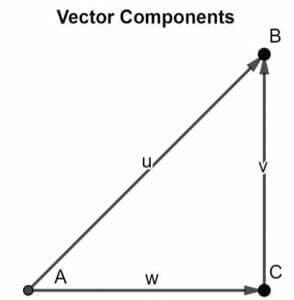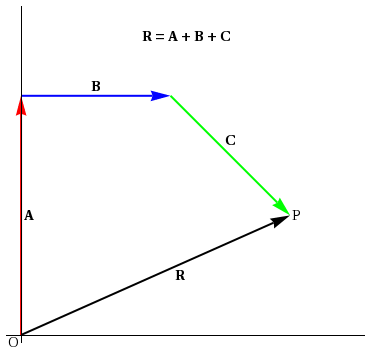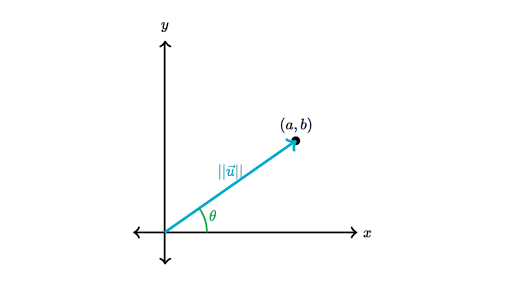The Direction Of The Resultant Of The Two Vectors Shown Below Can Be Determined
Len SquareRoot directionx directionx directiony directiony. Next to find their sum we draw a resultant vector R such that it connects the tail of.
28 ms2 15ms2.

The direction of the resultant of the two vectors shown below can be determined. Figure a shows the vectors for two forces acting on the point P at an angle of 60 to each other. I make short to-the-point online math tutorials. If only two forces are involved as shown in below figure the magnitude and direction of the resultant force can be determined by drawing to scale a parallelogram of forces.
Thus youll have a unit direction vector and the angle of the vector. If the two vectors are not. Find the resultant of the three vectors shown in figure 2W1.
This Pythagorean approach is a useful approach for adding any two vectors that are. This new arrow represents the vector -b a with -b being the opposite of b see drawing. And -b a a b.
We first place the given vectors A and B such that the tail of the vector-B connects to the head of the vector A as shown in the image below. The solution is shown below the diagram. The direction is simply subtraction of the two vectors.
This angle theta is the angle that the resultant makes with west. The head to tail method to calculate a resultant which involves lining up the head of the one vector. Videos you watch may be added to the TVs watch history and.
Here is the angle between the two vectors. Solution We first draw the negative of vector B by reversing its direction ie -BNext we add the vectors A and B by applying the head-to-tail method. ResultantVector PhysicsClass11 simplescience In this video we study how to calculate the magnitude and direction of resultant of two vectors.
When the two vectors are added head-to-tail as shown below the resultant is the hypotenuse of a right triangle. To subtract b from a place the tails of a and b at the same point and then draw an arrow from the head of b to the head of a. And the resultant vector is located at an angle with the OA vector.
R 2 i 3 j k i 2 j 4 k i 5 j 3 k R 1 2 5 2 3 2 1 2 5 9 3 5 Unit vector in the direction of resultant vector of A and B is R R R 3 5 i. Suppose the two vectors are A and B NOW If they are parallel to each other their resultant will be the sum of those two vectors. Calculate the magnitude and direction of the resultant of the two acceleration vectors shown below.
Direction v2 - v1. Usually you have to normalize this to get a unit vector. If playback doesnt begin shortly try restarting your device.
The sides of the right triangle have lengths of 11 km and 11 km. Suppose as shown in the figure below OA and AB indicate the values and directions of the two vectors And OB is the resultant vector of the two vectors. Vector addition is different from addition of two numbers because we must account for both the magnitude and direction of the vectors.
Resultant vector physics resultant. The tangent function as in TOA relates the angle. A common example is summation of forces acting on an object to find the resultant.
The direction of the resultant can be determined by finding the angle that the resultant makes with either the north-south or the east-west vector. To find the resultant vector we must use vector addition summation. Equality of Two Vectors Two vectors are equal if they have the same magnitude and the same direction A B if A B and they point along parallel lines All of the vectors shown are equal.
Methods for calculating a Resultant Vector. The resultant can be determined using the Pythagorean theorem. It has a magnitude of 156 km.
There are a two different ways to calculate the resultant vector. Calculate the magnitude and direction of the resultant of the two acceleration vectors shown below. Thus the value of the resultant vector will be according to this formula.
Its value can be determined using the tangent function. Vector - a quantity defined by both magnitude and direction Scalar addition - the algebraic sum of two or more quantities Vector addition If two vectors are parallel being in the same opposite direction their magnitudes can be added subtracted to obtain the magnitude of the Resultant Vector. For example- If the two vectors are A and B and they are parallel to each other then their resultant will.
The resultant vector is the vector that results from adding two or more vectors together. The diagram at the right shows the angle theta marked inside the vector addition triangle. Subtraction of two vectors can be geometrically illustrated as follows.
I struggled with math growing up and have been able to use those experiences to help students improve in ma.

Find The Magnitude And Direction Of The Resultant Of Two Vectors A And B In The Terms Of Their M Youtube

Which One Doesn T Belong Concept Builder A Tool That Allows The Learner To Relate Kinematic Informatio Body Diagram Which One Doesnt Belong Physics Projects

Match That Free Body Diagram Concept Builder Challenges A Learner To Utilize An Understanding Of Force Types In Order T Body Diagram Physics Physics Projects

Net Force Ranking Tasks Concept Builder Provides Learners An Opportunity To Use The Concept Of Net Force And Newton S Seco Physics Projects Body Diagram Force
How To Find The Direction Of The Resultant Of A Vector Quora

Finding Magnitude And Direction Of Resultant Vectors Youtube

Vector Addition And Subtraction Analytical Methods Physics

Solve It With Newton S Second Law Concept Builder This Interactive Exercise Provides Plenty Physics Projects Newtons Second Law Science Lessons High School
Converting Between Vector Components And Magnitude Direction Review Article Khan Academy

Part A Problem 1 A For The Forces Shown In The Chegg Com
How To Find The Magnitude And Direction Of A Force Given The X And Y Components Phyley

Vector Components Explanation And Examples

How To Find The Direction Of The Resultant Of A Vector Quora

Ex Vector App Find The Resultant Vector Of A 2 Direction Walk Youtube

5 2 Vector Addition And Subtraction Analytical Methods Texas Gateway

Motion In A Plane Cbse Notes For Class 11 Physics Learn Cbse Class11physicsnotes Motioninaplanephysicsclass11 Physics Notes Physics Projectile Motion

Motion In A Plane Cbse Notes For Class 11 Physics Learn Cbse Class11physicsnotes Motioninaplanephysicsclass11 Physics Notes Physics Study Notes
Force Of Magnitude 4n 6n And 8n Act Along Sides Of An Equilateral Triangle Abc What Is The Magnitude And Direction Of The Resultant Force Quora



Comments
Post a Comment